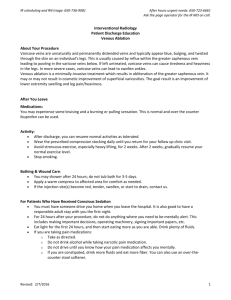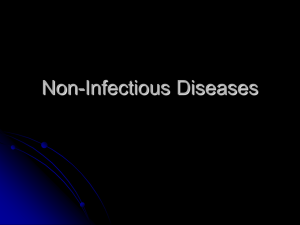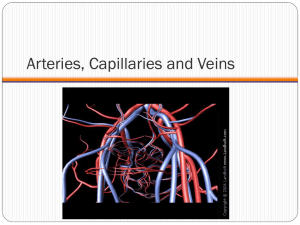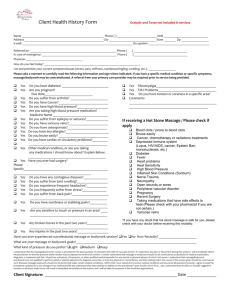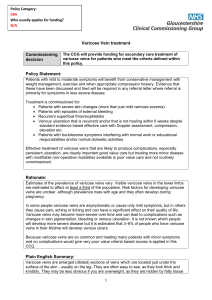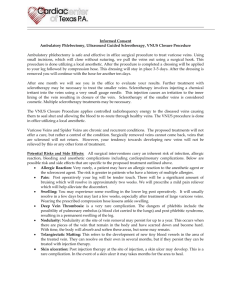Andy Francis - Hidden Briar Wellness
advertisement
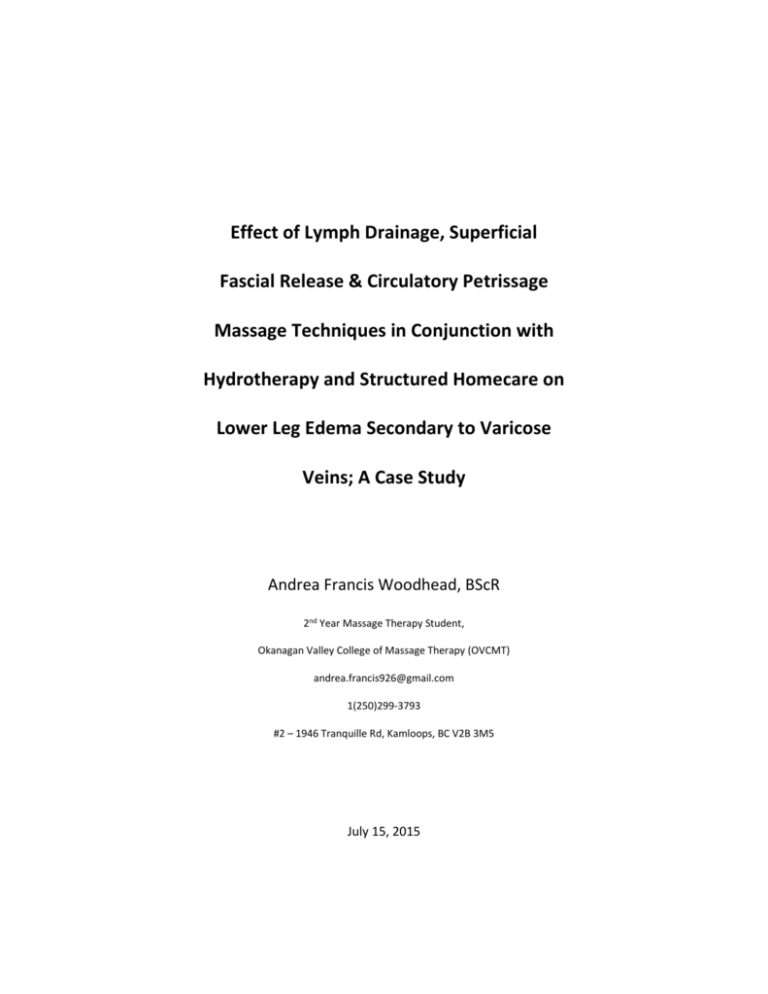
Effect of Lymph Drainage, Superficial Fascial Release & Circulatory Petrissage Massage Techniques in Conjunction with Hydrotherapy and Structured Homecare on Lower Leg Edema Secondary to Varicose Veins; A Case Study Andrea Francis Woodhead, BScR 2nd Year Massage Therapy Student, Okanagan Valley College of Massage Therapy (OVCMT) andrea.francis926@gmail.com 1(250)299-3793 #2 – 1946 Tranquille Rd, Kamloops, BC V2B 3M5 July 15, 2015 Table of Contents Abstract………………………………………………………………………………………………………………3 Introduction…………………………………………………………………………..…………………………..5 Subject Case History……………………………………………………………………………………………8 Assessment...………………………………………………………………………….………………………..11 Treatment Plan………………………………………………………………………………………………...12 Outcomes………………………………………………………………………………………………………...17 Discussion and Conclusion…………………………………………………………..……………………25 References……………………………………………………………………………………………..………..29 Appendix A: Pre & Post Assessment Measurements Table…...…………………..…………30 B: Pre & Post Treatment Images…...………………………………………………………31 C: Homecare Tracking Table…….……………………………………………………………36 Effects of Massage on Edema Secondary to Varicose Veins 2 Abstract Objective: This case study was designed to investigate the effectiveness of using lymph drainage, superficial fascial release and circulatory petrissage massage techniques in conjunction with hydrotherapy and structured homecare to treat lower leg edema that is present secondary to varicose veins to decrease girth measurement, increase range of motion and decrease feeling of fullness in the limb. Background: The patient being treated is a 62 year old female who developed edema in her lower legs after she developed varicose veins while pregnant with her second child in 1987. She experiences an increase in symptoms after long days of sitting at work or on very hot days. Method: 8 - 60 minute massage treatments were done over a 2-3 week period (one treatment every 2 – 3 days). Pre vs. post treatment assessments were done including: girth measurements, active & passive range of motion of the talocrural joint, patient’s report of feeling of fullness (1-10 scale) and the pitted edema test. Visual images were also taken to show the effectiveness of treatment. Treatment included: basic lymph drainage techniques, superficial fascial release and circulatory petrissage strokes performed over the whole anterior and Effects of Massage on Edema Secondary to Varicose Veins 3 posterior lower extremity. Hydrotherapy was applied during treatment and the patient was given structured homecare to do between treatments. Results: As a result of the massage treatments and homecare the patient’s lower leg girth measurements decreased by 9.1% - 12.5% and the patients reported feeling of fullness decreased from 8/10 to 3-4/10. Also seen, was a change in the tissue colour on the patient’s right medial malleolus, from purple to a faded red hue. Conclusion: The results show that the combination of lymph drainage, superficial fascial release, circulatory petrissage, and hydrotherapy in tandem with structured homecare is an effective treatment for decreasing symptoms caused by edema in the lower leg secondary to varicose veins. Keyword List Lymph drainage, superficial fascial release, circulatory petrissage, hydrotherapy, homecare, varicose veins, edema, lower limb, girth measurements, massage. Effects of Massage on Edema Secondary to Varicose Veins 4 Introduction Edema is the local or general accumulation of fluid in the interstitial spaces (Rattray, 2000). This accumulation of excess fluid builds up as it is pumped into the capillary bed from the circulatory system and not reabsorbed. Once this fluid is in the lymph system it is referred to as lymph; lymph is made up of white blood cells, plasma proteins, fats and debris suspended in a watery fluid (Rattray, 2000). Lymph vessels have minor contractile ability; the majority of lymph movement around the body, and back to the heart, is driven by skeletal muscle and respiratory (diaphragm) pumps (Rattray, 2000). When lymph pools or accumulates in the interstitial spaces it can be as a result of increased permeability of the capillaries in an area, increase capillary pressure, decrease in plasma proteins or an obstruction to a part of the lymphatic system (Rattray, 2000). This pooling, or edema, can cause swelling, pain, discomfort and loss of function in the affected area (Rattray, 2000). Anybody can develop edema and it can develop anywhere in the body. Those who have had a traumatic injury are more likely to have edema caused by damage to the lymphatic system. Surgical removal of nodes is also a common cause of edema, for example: lymph nodes and tissues are commonly damaged Effects of Massage on Edema Secondary to Varicose Veins 5 or removed during a mastectomy. Edema can also be caused by any increase in venous pressure due to: heart disease, pregnancy, localized infection or an allergic reaction. Edema can also be secondary to kidney disease as well as extensive tissue damage or burns which cause an increase in plasma proteins (Rattray, 2000). Varicose veins are gnarled, enlarged veins that have lost their elasticity and have non-functioning valves (Mayo Clinic, 2013). Veins return blood to the heart through a system of one way valves and skeletal muscle pumps. There are many reasons why a person develops varicose veins but it is most commonly caused by a sustained increase in venous pressure. For that reason, they are most commonly developed in the lower extremity as the blood returning to the heart has to compete with gravity (Mayo Clinic, 2013). Age, sex, family history, obesity, pregnancy and standing or sitting for long periods of time increase a person’s risk of developing varicose veins (Mayo Clinic, 2013). Woman more commonly experience varicose veins (Jordan, 2001). Due to the body’s inability to return blood to the heart adequately, and an increase in venous pressure, with the presence of varicose veins a person is more likely to experience edema distal to the damaged veins as fluid pools into the interstitial spaces. Effects of Massage on Edema Secondary to Varicose Veins 6 Though there is not currently any specific research on treating lower leg edema secondary to varicose veins, there has been some research done on treating upper extremity edema and lymphedema secondary to a mastectomy. This research, though related, is different from the condition being treated in this study as the patient’s varicose veins and subsequent medical intervention did not cause any damage to the lymphatic tissues. The few studies that have been found that reference the treatment of leg lymphedema were completed in 2002 and 2003 and studied the effects of Manual Lymph Drainage and the Vodder method on the lymphedema. These techniques were shown to have a significant effect on the lymphedema present (14-19% reduction in limb volume) (Harris, 2004). Patients in these studies did not have any reported varicose veins. There have been no studies found that address the application of myofascial release techniques or hydrotherapy on the type of edema present in this study but such techniques are indicated as per “Clinical Massage Therapy” by Rattray (2000). Alternatively to massage both edema and varicose veins are commonly treated using “compression therapy”, the use of compression garments such as socks or sleeves (Rattray, 2000). These garments are used to assist the vessels with returning blood and lymph to the heart by decreasing the capillary pressure and Effects of Massage on Edema Secondary to Varicose Veins 7 assisting against gravity. Some edema is also treated with the use of medications such as diuretics (Rattray, 2000). This case study is designed to prove the hypothesis that using the combination of lymph drainage, superficial myofascial release and circulatory petrissage massage techniques in conjunction with hydrotherapy applications and structured homecare will have a positive effect on lower leg edema secondary to varicose veins. This positive effect will be assessed by: a decrease in overall girth measurements, increased active and passive range of motion at the talocrural joint and decrease in overall feeling of fullness. Subject Case History The patient being treated for this study is a 62 year old female that developed varicose veins in 1987 while pregnant with her second child. Some of the varicose veins were treated in 1995 using medical intervention to help decrease the associated pain; the patient was unable to acquire any medical records to determine what type of medical intervention was done. The edema that the patient is experiencing has been present since the varicose veins developed in 1987 and has continued since having the procedure done on the veins in 1995 Effects of Massage on Edema Secondary to Varicose Veins 8 with no change. After speaking with her family doctor, the patient reported, it was very unlikely that any of the surrounding lymph tissues were damaged during the corrective intervention. The patient does not currently use any form of compression garment or diuretic medication to help control the edema in her lower extremities. In the past when the patient used compression garments (socks) for a short time she reports that they were uncomfortable and “did not help the swelling”. The edema being treated is present in both lower extremities (bilaterally), most significantly in the lower leg, between the ankle (talocrural joint) and knee, and is present at all times. The edema is reportedly worse after long periods of sitting, especially on hot days, and not exercising consistently. The patient is a business owner and spends the majority of her workday sitting at a desk. Though she is very active in the spring/summer in the garden 3-4 days per week she is significantly more sedentary during the fall/winter. The patient reports that what she feels in her legs is better described as “fullness or discomfort” rather than pain. The patient has never been treated using any manual therapy (including massage) for this condition. She is not currently seeing any other practitioners Effects of Massage on Edema Secondary to Varicose Veins 9 for treatment of this or any other condition other than her family Doctor for regular checkups. The patient does not have any other known risk factors for developing edema (ex. Kidney failure, heart disease, extensive tissue damage or burns, etc…) and is not currently on any medications other than a daily multivitamin, an antidepressant for mild anxiety and Zomig for recurrent, long standing, migraines (40+ years). Currently, the patient does not do anything specific, or consistently, to help decrease the swelling and edema in her legs, she does report that sitting in the evening with her feet on a foot stool helps sometimes. The patient reports that the edema does not currently affect her activities of daily living (ADL’s) that she can pinpoint; though, she does report that on very hot summer days she cannot stop and start activity (gardening or walking) as her legs will swell during the breaks and it is uncomfortable to continue. The patient is hoping to have a decrease in the feeling of fullness in her lower legs as a result of the treatment throughout this case study. She also reports that there is a cold, purple area of tissue around her right medial malleolus that she has never had diagnosed or treated. The patient reports she has always “been curious and a little concerned about it” and is “curious if these treatments will Effects of Massage on Edema Secondary to Varicose Veins 10 have an effect on the area”. Upon observation the area indicated appears to be a cluster of spider veins. This area will be monitored for change but is not the main focus of this study as it has not been diagnosed by a medical professional. Below are images of the patient’s lower legs showing the varicose veins and present edema prior to starting treatment. Assessment As per Rattray (2000), the presence and treatment of edema can be assessed in a number of different ways. Edema will be evident during observation with noticeable swelling and on palpation where the tissues can feel taut, boggy or “squishy”. The patient may also exhibit limited range of motion (ROM) with potentially boggy end feels at passive over pressure depending on the severity. Tissue may be hot (in acute stage) or cool (in chronic stage) due to ischemia. Effects of Massage on Edema Secondary to Varicose Veins 11 Girth measurements may also be used to determine amount of swelling, these measurements can be compared bilaterally and/or as a pre/post objective assessment tool. Therapists may also use the pitted edema test to test for the presence of pitted vs. non pitted edema (Rattray, 2000). To measure the effectiveness of this study, using the combined use of lymph drainage, superficial myofascial release and circulatory petrissage techniques in conjunction with hydrotherapy applications and structured homecare on lower leg edema secondary to varicose veins, a combination of objective and subjective data will be assessed. Objective data to be measured and assessed: - Girth Measurements of the lower leg (9cm above the medial malleolus, where the edema is most observable and palpable) - Active and passive range of motion - dorsiflexion and plantarflexion at the talocrural (ankle) joint - Pitted Edema Test - Observed change in colour of tissue around right medial malleolus Subjective data to be measured and assessed: Effects of Massage on Edema Secondary to Varicose Veins 12 - Fullness Scale (Scale of 1(low) – 10(high), as reported by the patient) All data will be collected pre and post each treatment and in the same location (if applicable). Images will also be taken throughout treatment to visually depict the treatment outcomes. Treatment Plan Based on the assessment of the patient’s physical presentation and the patient’s personal goals, the treatment goals and objectives of this case study are to: 1. Decrease Sympathetic Nervous System (SNS) firing to stop pain cycle and promote full body healing. 2. Decrease edema in bilateral (BL) lower legs to decrease girth measurement, increase active (A) and passive (P) range of motion (ROM) at the talocrural (TC) joint and decrease feeling of fullness. 3. Decrease superficial fascial restrictions in/over bilateral (BL) hamstrings (HS), quadriceps (quads), Gastrocs (gas), soleus (sol) and tibialis anterior (TA) muscle groups to decrease compression of lymph vessels and increase fluid mobility. 4. Increase circulatory flushing to remove metabolites, promote venous Effects of Massage on Edema Secondary to Varicose Veins 13 return and increase tissue health in bilateral (BL) lower extremity. As per previous studies of similar conditions there have not been best practices established related to the ideal number of treatments, or duration of treatments, that is most effective for this condition. In this case study a total of 8 – 60 minute treatments will be performed every 2 or 3 days, for 2-3 weeks. The time of each treatment will be recorded to see if there is any correlation between outcomes and time of treatment. A structured homecare plan will be given to the patient, with a tracking sheet to complete, to determine the effect of the homecare on maintaining the outcomes achieved. As outlined in Rattray (2000), and throughout the research, some techniques that are indicated to treat chronic lower leg edema that is secondary to varicose veins include: warm/cool hydrotherapy to increase/decrease blood flow to and from the area of congestion, putting the legs on an incline elevated above the heart to aid in venous return, releasing myofascial restrictions to increase venous/lymph return/flow, Swedish/petrissage circulatory strokes in the direction of the heart moving from distal to proximal to enhance venous return, lymph drainage techniques (full body or local) following the pattern described in Rattray and the basic Vodder method and, mid to full passive range of motion to Effects of Massage on Edema Secondary to Varicose Veins 14 increase circulation and tissue health. Based on the techniques proven to be effective, throughout this case study the following treatment procedure was used to address the treatment goals as outlined above: (Procedures 1-4 relate directly to goals 1-4 above) 1. Deep Diaphragmatic Breathing (DDB), full body rocking (rock), compressions (comp) to anterior/posterior legs, shaking to full legs. 2. - Lymph Drainage techniques (as outlined in Rattray): Node pumping (Sacrum, BL popliteal fossa, BL inguinal triangle – 7x), Broad hand scooping inferior to superior towards superior nodes (5-7 repetitions/scoops at each hand placement moving superior to inferior down the limb, 2 full cycles over anterior and posterior full leg BL). - Mid-range PROM of Hip (flexion, internal/external rotation, abduction/adduction) /Knee (flexion/extension)/ TC (dorsiflexion/plantarflexion) 3-5 repetitions in each direction. 3. Broad cross hands spreading myofascial release (MFR) into restriction and superficial fascial skin rolling over BL HS, quads, gas/sol, TA muscle groups. Effects of Massage on Edema Secondary to Varicose Veins 15 4. Circulatory petrissage (Effleurage, Open-C, Wringing) to BL anterior and posterior lower extremity (HS, quads, gas/sol, TA muscle groups & feet) – flushing strokes done in direction of the heart. Ending with ~3 long distal to proximal effleurage strokes. - Patient was positioned prone and turned to supine with ankles pillowed above heart level throughout the study to encourage blood/fluid return to heart with the aid of gravity. - Hydrotherapy: Heat (Thermaphore) to encourage derivation (drawing blood/fluid) towards the heart was applied to low back (prone) and abdomen (supine), cold towels to encourage retrostasis (pushing/driving blood/fluid) towards heart were applied to feet throughout treatment. - Procedures 2-4 were repeated in order to BL posterior legs then to BL anterior legs. As part of this case study the patient was given a series of daily homecare exercises to complete to compliment and maintain the effects of the massage treatments. These exercises include: 1. 10min walk at lunch time to encourage movement and activate the Effects of Massage on Edema Secondary to Varicose Veins 16 skeletal muscle pumps that pump blood and lymph back to the heart. (1x/day) 2. Elevate feet and legs above heart level with cold towel on feet for 15mins to encourage blood and fluid drainage from legs to heart using retrostasis and gravity. (1x/day) 3. Active ROM of TC joint “drawing alphabet with big toe” to encourage joint movement and activate skeletal muscle pump to help return blood to the heart via venous system and encourage lymph return. (2x/day – morning & evening) Throughout the 8 treatments some modifications were made based on the needs and requests of the patient and findings in previous or current treatment, as noted in Appendix C. Outcomes The most significant change in the patient’s lower leg edema was observed in the data collected of pre and post treatment girth measurements. All girth measurements were taken bilaterally at 9cm above the medial malleolus where the initial edema was most observable and palpable. Figure 1 shows a plot graph of pre and post girth measurements taken of the right lower leg. After 8 Effects of Massage on Edema Secondary to Varicose Veins 17 treatments performed, as outlined above, there was a successful decrease in girth of 3.5cm from pre treatment 1 to post treatment 8 measurements; equal to Girth Measurement @ 9cm Superior to Medial Maleolus (cm) 12.5% decrease in limb girth. Figure 1 - Lower Leg Girth Measurements - Right 29 28 27 26 25 24 23 27.9 27.3 27.3 26.2 26 26.2 27 26.3 26.2 25.3 1 2 3 4 25.8 5 25.4 25.2 24.5 24.4 7 8 25.6 6 Pre Treatment Measurement Post Treatment Measurement Treatment Number Figure 2 shows the pre and post girth measurements taken of the left lower limb at the same level as the right leg. Similar to the right leg, the left leg decreased in overall girth measurement. Girth measurements on the left decreased by 2.5cm, or 9.1% of limb girth. During treatment 2 the patient was positioned supine and then turned to prone rather than starting prone. All other treatments were performed with the patient positioned prone to start and then turned supine; all other treatments Effects of Massage on Edema Secondary to Varicose Veins 18 measured a decrease in girth measurement, while a .3cm increase resulted Girth Measurement @ 9cm Superior to Medial Maleolus (cm) during treatment 2. Figure 2 - Lower Leg Girth Measurements - Left 27.5 27 26.5 27.3 27 26.7 26.7 26.5 26.1 25.8 26 25.5 26 25.9 26 25.6 25.5 25 24.5 25.4 25.2 24.9 24.8 Pre Treatment Measurement Post Treatment Measurement 24 1 2 3 4 5 6 7 8 Treatment Number Also seen in both figures 1 and 2 the pre treatment girth measurement taken before treatments 5 and 7 were smaller than the post treatment girth measurements taken after the treatment prior. There was a decrease of .5cm(R) and .2cm (L) between treatments 4 and 5 and a decrease of .6cm (BL) between treatments 6 and 7. Prior to treatment 5 the patient completed 100% of her homecare and prior to treatment 7 the patient reported spending the morning/afternoon before treatment gardening at moderate intensity (engaging skeletal muscle pumps). She also reported having a severe migraine the day before (patient slept most of the day or relaxing with feet up not allowing Effects of Massage on Edema Secondary to Varicose Veins 19 fluid/blood to pool in lower leg). This data suggests that the homecare given to the patient as well as commitment to self-care has a positive effect on decreasing edema in the lower leg. Figures 3 (right) and 4 (left) show the pre and post measurements of active and passive dorsiflexion range of motion at the talocrural (TC) joint. Though the patient’s range of motion was not severely limited by the edema on either right or left there was a measureable increase in active TC dorsiflexion pre treatment measurements on the left (Figure 4) from 10 degrees (pre treatment 1) to 17-20 degrees (pre treatments 7 & 8). There were no other consistent measurable Range of Motion (Normal = 20 Degrees) Values in Degrees changes throughout the study in these ranges. Figure 3 - Talocrural Range of Motion Dorsiflexion - Right 25 20 AROM Pre AROM Post 15 10 PROM Pre 5 0 1 2 3 4 5 6 7 8 PROM Post Treatment Number Effects of Massage on Edema Secondary to Varicose Veins 20 Range of Morion (Normal = 20 Degrees) Values in Degrees Figure 4 - Talocrural Range of Motion Dorsiflexion - Left 25 20 15 10 5 0 1 2 3 4 5 6 7 8 AROM Pre AROM Post PROM Pre PROM Post Treatment Number Figures 5 (Right) and 6 (Left) show the pre and post measurements of active and passive plantarflexion range of motion at the TC joint. As with dorsiflexion, the patients’ plantarflexion was not severely limited on the right or left. Upon assessment the only consistent measureable change was recorded at the left TC joint (figure 6): active and passive ranges were both increased by 5-10 degrees Range of Motion (Normal = 50 Degrees) Values in Degrees pre treatment 2 to post treatment 8. Figure 5 - Talocrural Range of Motion Plantarflexion - Right 60 40 AROM - Pre 20 AROM - Post PROM - Pre 0 1 2 3 4 5 6 7 8 PROM - Post Treatment Number Effects of Massage on Edema Secondary to Varicose Veins 21 Range of Morion (Normal = 50 degrees) Values in Degrees Figure 6 - Talocrural Range of Motion Plantarflexion - Left 60 50 40 AROM - Pre 30 AROM - Post 20 PROM - Pre 10 PROM - Post 0 1 2 3 4 5 6 7 8 Treatment Number Figure 7 shows a measureable decrease in the patients reported feeling of fullness, on a scale of 1-10. The greatest decrease was seen pre vs. post treatment 1 from 8/10 to 5/10. By the end of the study (post treatment 8) there was a significant decrease in fullness with patient reporting her legs feeling 3/10(left) and 4/10(right) on the fullness scale; decreasing the patients feeling of fullness by 50 – 62.5% over the course of treatment. Effects of Massage on Edema Secondary to Varicose Veins 22 Feeling of Fullness Scale 1(low) - 10(high) Figure 7 - Feeling of Fullness as Reported by Patient Pre and Post Treatment (Right and Left) 10 8 6 Right - Pre 4 Right - Post 2 Left - Pre 0 Left - Post 1 2 3 4 5 6 7 8 Treatment Number No change was seen in the pitted edema test throughout the study. All pre and post treatment tests were negative for pitted edema. Figures 1, 2 and 7 show that the treatments were successful in achieving the goals of decreasing the patient’s lower leg girth and decreasing the patient’s reported feeling of fullness. Figures 3 thru 6 showed a small overall increase in active and passive range of motion at the TC joint even though the patient, unexpectedly, did not start the study with a significant deficit in these ranges. Effects of Massage on Edema Secondary to Varicose Veins 23 Shown in the images below is the unexpected effect the treatment had on the purple tissue discolouration on the patients’ right medial malleolus. The colour of the tissue faded as treatments progressed from a diffuse purple colour with multiple darker purple capillaries spread throughout to a dull red hue with very few darker capillaries scattered throughout. Post Treatment 2 Post Treatment 6 Pre Treatment 8 See appendix for more pre and post treatment images for visual depiction of results achieved. Throughout the study the patient was given the same daily homecare (outlined above) and asked to track her completion of each exercise. Overall the patient completed her homecare 83.8% of the time. The time the treatments took place had little to no effect on the outcomes of Effects of Massage on Edema Secondary to Varicose Veins 24 this study as evidenced by no correlation seen in the data between changes in girth measurements and the time of day the treatment took place. Ongoing long term assessment was scheduled for 4, 6 and 8 weeks after the completion of this study to determine the long term effects of the treatment series as well as help determine the best long term treatment frequency. The patient was given an ongoing homecare tracking sheet for that time. 4 weeks post treatment 8 (April 27, 2015) the patient reported that her feeling of fullness had increased slightly to 4/10 bilaterally, there was no decrease in her talocrural active and passive range of motion in all ranges, and her girth measurements were 26.2cm(R) and 26.3cm(L); similar to measurements taken during treatment 4. Though the patient was not diligent on recording the homecare she had completed during the first 4 weeks after treatment she reported that she did “about half” of the exercises. 6 and 8 week follow up assessments were unable to be completed as the patient was traveling unexpectedly during these times. Included in appendix: table of pre and post measurements, visual images taken throughout treatment, and patients completed homecare tracking sheet. Effects of Massage on Edema Secondary to Varicose Veins 25 Discussion and Conclusion Based on the outcomes achieved in this case study the combined use of lymph drainage, superficial myofascial release and circulatory petrissage massage techniques in conjunction with hydrotherapy applications and structured homecare has a positive effect on decreasing symptoms of lower leg edema secondary to varicose veins by noticeably decreasing the overall girth measurements, by 9.1%-12.5%, and decreasing patient reported feeling of fullness, by 50 - 62.5%, in the lower legs bilaterally. These techniques were also shown to have an unexpected effect on long standing tissue discolouration and capillary blood pooling around the patient’s right medial malleolus. More research should be done to solidify this data. A significant effect on range of motion (active or passive) at the talocrural was not shown as the patient being treated did not have significantly decreased initial ranges. There was also a significant decrease in the visible size and colour of the varicose veins bilaterally (below). Effects of Massage on Edema Secondary to Varicose Veins 26 Pre Treatment 1: Post Treatment 8: This study also supported the best practice of elevating the feet above the heart level to aid in blood and fluid return to the heart. It was also noted, through data collected during treatment 2, that positioning of the patient (Prone to supine vs. supine to prone) may have an effect on treatment outcomes, more research is needed to support this. This case study supports research already done on the effectiveness of lymph drainage techniques on edema in general (Harris, 2004); it specifically confirms the technique’s positive effects on lower leg edema secondary to varicose veins. This study also shows that superficial myofascial techniques, hydrotherapy and structured homecare have a positive effect on helping treat this condition and decrease symptoms. It was shown through data collected that when the patient Effects of Massage on Edema Secondary to Varicose Veins 27 was able to complete all or most of her homecare the results of the massage treatments were sustained for longer. Due to the nature of this condition, the edema being as a result of a structural venous change, it is expected that treatment will need to be ongoing. As an initial treatment plan this series of 8 treatments with one treatment every 2-3 days was effective but would not be cost effective for long term treatment. It would be reasonable to expect, from the data collected (similar girth and fullness measurements throughout the last week of treatment), that the same sustained results could be obtained by 1 treatment per week if the patient is able to maintain commitment to her homecare/self-care. These treatments could become less frequent (1 every 2/3 weeks, or longer) once outcomes were able to be maintained between treatments with homecare/self-care. This potential long term care plan was supported by measurements taken 4 weeks after treatment ended; during the weeks post treatment the patient reported that she was 50% compliant with her homecare/self-care plan. The patients girth measurements increased by 1.8cm (R) and 1.5cm (L) but still remained less than original measurements. To determine the best treatment plan for any patient with this condition factors such as: the patients overall Effects of Massage on Edema Secondary to Varicose Veins 28 health, budget/benefits package, willingness to comply with homecare recommendations must be taken into consideration. The patient was surprised and excited about the effect that this type of treatment had on an issue that she considered to be normal for her and unlikely to change. The patient is most excited about the change in colour of the tissue around her right medial malleolus. The patient reports being open and willing to continue with the ongoing homecare and seeking out this type of massage treatment on an ongoing basis for maintenance. With the results she has seen from massage for this condition the patient is also reportedly more willing to seek massage as a potential treatment for other conditions (migraines). Effects of Massage on Edema Secondary to Varicose Veins 29 References 1. Rattray, Fiona and Ludwig, Linda, 2000, Clinical Massage Therapy: Understanding, Assessing and Treating over 70 Conditions, Talus Incorporated, Ontario, Canada. 2. Varicose Veins Mayo Clinic, January 2013, http://www.mayoclinic.org/diseases-conditions/varicoseveins/basics/definition/con-20043474 3. Jordan, Kate, NCTMB, 2001, What about Varicose Veins Massage Today, Volume 1, Issue 5. 4. Harris, R.H. and Piller, N.B., February 29, 2004, Research Shows Effectiveness With Lymphoedema Patients, Massage Therapy Canada. 5. Magee, David J., 2008 Orthopedic Physical Assessment, (5th edition), Sanders, Canada. 6. Hertling, Darlene and Kessler, Randolph M., (2005) Management of Common Musculoskeletal Disorders, (4th edition), Wolters Kluwer. 7. Harris, R.H. and Piller, N.B., 2003, Three case studies indication the effectiveness of manual lymph drainage on patients with primary and secondary lymphoedema using objective measuring tools, Journal of Bodywork and Movement Therapies, 7 (4) 213 – 223. 8. Goats, Geoffrey, 1994, Massage - the scientific basis of an ancient art: part 2. Physiological and therapeutic effects Br J SP Med, 28(3) Effects of Massage on Edema Secondary to Varicose Veins 30 Appendix A: Pre and Post Measurements of Data Assessed Date m/d/y 3/14/15 @ 1pm Measurement taken 9cm superior to medial malleolus Girth Measurement – Girth Measurement – Pre Post L R L Pre Post 27.9cm 27.3cm 27.0cm (-0.9cm) 26.7cm (-0.6cm) R Neg. R Neg. R L Neg. L Neg. L R Neg. R Neg. R 27.3cm 26.7cm 26.3cm (-1.0cm) 27.0cm (+0.3cm) Fullness: Pre (6/10 – BL) Post (4/10 – BL) 3/18/15 @ 9am 27.3cm 26.1cm 25.3cm (-2.0cm) L Neg. 25.8cm (-0.3cm) Fullness: Pre (5/10 – BL) Post (4/10 – BL) 3/21/15 @ 11am 26.2cm 26.5cm 26.2cm (+/- 0cm) 26.0cm 25.9cm 25.8cm (-0.2cm) 26.0cm (-0.5cm) 26.2cm 26.0cm 25.6cm (-0.6cm) 25.6cm (-0.3cm) 25.4cm 25.2cm 24.5cm (-0.9cm) 25.5cm (-0.5cm) 25.2cm 25.4cm 24.4cm (-0.8cm) Fullness: Pre (4-5/10 – BL) Post (4/10 – R, 3/10 – L) R Neg. L Neg. 24.9cm (-0.3cm) Fullness: Pre (5/10 – BL) Post (3/10 – R, 4/10 – L) 3/30/15 @ 5pm R Neg. L Neg. Fullness: Pre (4/10 – BL) Post (4/10 – R, 3/10 – L) 3/27/15 @ 8pm R Neg. L Neg. Fullness: Pre ( 5/10 – BL) Post (4/10 – BL) 3/25/15 @ 6:30pm R Neg. L Neg. Fullness: Pre (5/10 – BL) Post (4/10 – R, 3/10 – L) 3/23/15 @ 6pm TC ROM – Dorsiflexion N = 20degrees R Fullness: Pre (8/10 – BL) Post (5/10 – BL) 3/16/15 @ 5:30pm Pitted Edema Test 24.8cm (-0.6cm) R Neg. L Neg. R Neg. L Neg. R Neg. L Neg. R Neg. L Neg. R Neg. L Neg. R Neg. L R Passive Active Passive Pre ~15 ~20 ~50 ~50 Post ~20 ~20 ~50 ~50 Pre ~10 ~15 ~50 ~55 Post ~20 ~20 ~50 ~55 Pre ~15 ~20 ~45 ~50 Post ~20 ~20 ~50 ~50 N/A Homecare & tracker given to pt. Pre ~15 ~17 ~40 ~45 Post ~20 ~20 ~45 ~45 Pre ~17 ~20 ~45 ~50 Post ~20 ~20 ~50 ~50 Pre ~15 ~15 ~40 ~45 Post ~20 ~20 ~45 ~50 6/8 L R Pre ~20 ~20 ~50 ~50 Post ~20 ~20 ~50 ~50 Pre ~15 ~15 ~45 ~45 Post ~20 ~20 ~45 ~50 10/12 L R Pre ~15 ~20 ~45 ~50 Post ~20 ~20 ~50 ~50 8/8 L R L R L Neg. L R Neg. R Neg. R L Neg. Active Homecare? 4 Homecare exercises given per day 5/8 L Neg. L Neg. TC ROM – Plantarflexion N = 50degrees Pre ~15 ~17 ~45 ~50 Post ~20 ~20 ~50 ~50 Pre ~20 ~20 ~45 ~45 Post ~20 ~20 ~50 ~50 Pre ~17 ~20 ~45 ~45 Post ~20 ~20 ~50 ~50 Pre ~20 ~20 ~50 ~50 Post ~20 ~22 ~55 ~55 Pre ~20 ~20 ~50 ~50 Post ~20 ~25 ~55 ~55 Pre ~15 ~17 ~45 ~50 Post ~20 ~20 ~50 ~50 Pre ~17 ~20 ~50 ~50 Post ~20 ~20 ~55 ~55 6/8 Unable to walk d/t work demands 5/8 Migraine yesterday – severe Gardening today 10/12 L Effects of Massage on Edema Secondary to Varicose Veins 31 Appendix B: Pre & Post Treatment Images #1: March 14, 2015 @ 1pm Pre: Post #2: March 16, 2015 @ 5:30pm Pre Effects of Massage on Edema Secondary to Varicose Veins 32 Post #3: March 18, 2015 @ 9am Pre – No images Available Post #4: March 21, 2015 @ 11am Pre Effects of Massage on Edema Secondary to Varicose Veins 33 Post #5: March 23, 2015 @ 6pm Pre – No Images Available Post #6: March 25, 2015 @ 6:30pm Pre Effects of Massage on Edema Secondary to Varicose Veins 34 Post #7: March 27, 2015 @ 8pm Pre Post Effects of Massage on Edema Secondary to Varicose Veins 35 #8: March 30, 2015 @ 5pm Pre Post Effects of Massage on Edema Secondary to Varicose Veins 36 Appendix C: Homecare Tracking Date Mar 14/15 10min Walk @lunch X Feet elevated w/ cool towel (15mins) - Alphabet Tracing (2x/day) X - Mar 15/15 X X X X Mar 16/15 X - X X Notes: (notes are regarding daily homecare modifications unless otherwise stated) Treatment 1: Cross fiber frictions around edema pocket @ BL lateral malleolus No cold towel when feet elevated Treatment 2: No cold towel on feet as per patient request; positioned supine to start treatment Mar 17/15 Mar 18/15 X X X X X X X No cold towel, Treatment 3: No cold towel on feet as per patient request Mar 19/15 Mar 20/15 Mar 21/15 X X X X - X X X X X X Mar 22/15 Mar 23/15 X X X X X X X X No cold towel Treatment 4: no modifications Treatment 5: no modifications Mar 24/15 Mar 25/15 - X X X X X X No cold towel, Treatment 6: No cold towel on feet as per patient request Mar 26/15 Mar 27/15 X X X X X X No cold towel Treatment 7: no modifications Mar 28/15 Mar 29/15 Mar 30/15 X X X X X X X X X X Treatment 8: no modifications X = complete - = incomplete Effects of Massage on Edema Secondary to Varicose Veins 37

